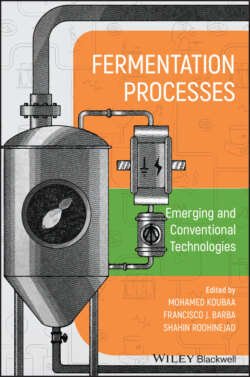Читать книгу Fermentation Processes: Emerging and Conventional Technologies - Группа авторов - Страница 9
1.1 Bioprocesses
ОглавлениеBioprocesses represent all the methods and techniques that use microbial, plant, or animal cells or their components (e.g. enzymes, proteins, genes, etc.) for the production of goods and services (Sindhu et al. 2017). Bioprocess technology is, in fact, an extension of the ancestral techniques used at the time to develop useful products (Kalaichelvan and Pandi 2019). Nowadays, microbial cells are not only used in common processes, such as for the production of alcoholic beverages (e.g. wine, beer, etc.) or dairy products (e.g. yogurt, cheese, etc.), but also to produce a wide diversity of complex molecules. In this sense, bioprocesses find many traditional or new applications in the following industries:
Agri‐food industry: production of animal proteins, amino acids, fermented foods and beverages, vitamins, enzymes, etc.
Chemical industry: production of organic acids, ethanol, solvents, polymers, biogas, etc.
Pharmaceutical industry: production of antibodies, vaccines, hormones, plasmids, steroids, etc.
Environmental industry: decontamination of wastewater, air, and soil; development of agricultural and industrial by‐products, etc.
In this respect, bioprocesses are exploited in three specific fields: fermentation processes, animal and plant cell cultures, and environmental bioprocesses. This chapter will mainly focus on conventional fermentation processes.
Most of the methods and techniques used in bioprocesses are based on fermentation technology. This is not surprising since the first ancestral processes were based on microbial fermentation. For most people, fermentation simply refers to the production of alcohol (beer and wine) or the deterioration of food by microorganisms (curd). Nevertheless, the word fermentation takes on a broader common industrial meaning. It is any process for producing a substance or biomass of cells on a large scale by using the culture of a microorganism, in aerobic or anaerobic conditions.
To be able to carry out these fermentations, it is imperative to cultivate microorganisms in tanks equipped with a certain number of more or less sophisticated systems; these tanks are called fermenters or bioreactors. Their role is to provide a controlled environment for optimal growth of microbial cells throughout the culture by constantly stirring the medium, infusing sterile air – in the case of aerobic fermentation – and controlling the temperature and pH of the fermentation broth. By using these tanks, contamination by other microorganisms is avoided by constantly maintaining asepsis conditions.
The first modern fermenters were designed in the 1950s to support the industrial production of penicillin and other newly discovered antibiotics. Since then, they have been able to control several other types of crops and to substantially increase the quantity of products marketed in each of the three fields of application of industrial bioprocesses mentioned above. Six major groups of products could then be obtained by fermentative processes, namely the production of (i) microbial biomass, (ii) microbial metabolites, (iii) microbial enzymes, (iv) recombinant proteins, (v) microbial plasmids, and (vi) bioconversion.
